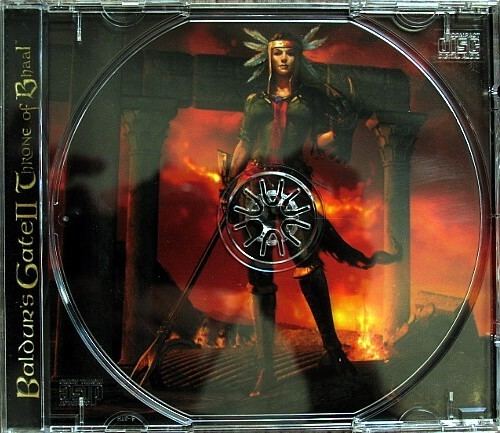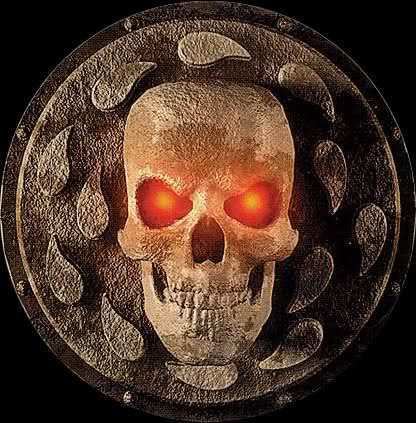Title(s) Lord of Murder Portfolio Murder | Alignment Lawful Evil | |
 | ||
Home plane 2E: Throne of Blood (Gehenna)3E: Barrens of Doom and Despair Power level Intermediate deity (deceased) Domains Death, Destruction, Evil, Retribution Similar Imoen, Elminster, Cyric, Minsc, Drizzt Do'Urden | ||
Bhaal (/bəˈhɑːl/ bə-HAHL), Lord of Murder, is a deity of the fictional Forgotten Realms campaign setting of the Dungeons & Dragons fantasy role-playing game.
Contents
- Publication history
- Advanced Dungeons Dragons 1st edition 1977 1988
- Advanced Dungeons Dragons 2nd edition 1989 1999
- Dungeons Dragons 35 edition 2003 2007
- History
- Death
- Literature
- References

Publication history
Ed Greenwood created Bhaal for his home Dungeons & Dragons game, set in the Forgotten Realms.
Advanced Dungeons & Dragons 1st edition (1977-1988)
Bhaal first appeared within Dungeons & Dragons as one of the deities featured in Ed Greenwood's article "Down-to-earth Divinity" in Dragon #54 (October 1981). Bhaal is introduced as Lord of Murder, the god of death, a lawful evil lesser god from the plane of Gehenna. The article states that "Bhaal strikes unerringly, and his dagger causes the area wounded to wither," and that he "rarely appears to worshippers or others, but is depicted by priests as a bloody, mutilated corpse with a feral face and silent movements. It is said that every murder done strengthens Bhaal. Myrkul is lord of the dead; Bhaal is the lord of death itself, the act of killing." Bhaal is described as one of “The Dark Gods” of evil alignment: "Loviatar, Talona, and Malar serve Bane through Bhaal (although Loviatar and Talona are rivals). Bhaal and Myrkul have an unbreakable, symbiotic alliance." Bhaal is commonly worshipped by assassins of any evil alignment, as well as lawful evil clerics.

Bhaal later officially appeared as one of the major deities for the Forgotten Realms campaign setting, in the Forgotten Realms Campaign Set's "Cyclopedia of the Realms" booklet (1987).
Advanced Dungeons & Dragons 2nd edition (1989-1999)
Bhaal was destroyed in the novel Tantras (1989), and its accompanying adventure module of the same name. Despite his death, Bhaal was still described in the hardback Forgotten Realms Adventures (1990), the revised Forgotten Realms Campaign Setting (1993) in the "Running the Realms" booklet, and Faiths & Avatars (1996).
His role in the cosmology of the Planescape campaign setting was described in On Hallowed Ground (1996).
His relationships with the nonhuman deities in the Forgotten Realms was covered in Demihuman Deities (1998).
Dungeons & Dragons 3.5 edition (2003-2007)
Bhaal's worship was discussed in Lost Empires of Faerûn (2005).
History
One of the Dead Three, Bhaal was originally a mortal, who along with Bane and Myrkul took the portfolios of the ancient deity Jergal. Despite his most common title, Bhaal was the god of Murder, but he especially favoured violent or ritual deaths.
Patron of Assassins, Bhaal was feared throughout Faerûn – especially in the island realm of the Moonshaes. A wholly evil, debased, and sadistic god, Bhaal was served by the goddesses Talona and Loviatar.
He was a Lawful Evil Intermediate Power, and his symbol was a skull encircled by a counterclockwise orbit of drops of blood. His divine Realm was the Throne of Blood (in Third Edition D&D, part of the Barrens of Doom and Despair). The Lost Empires of Faerûn Forgotten Realms supplement gives his 3.5 edition D&D domains as Death, Destruction, Evil and Retribution (Dragon magazine issue #322 instead gives his domains as Death, Destruction, Evil, Hatred and Law).
Death
Despite his power, during the Time of Troubles, when the gods were forced to walk Faerûn, Bhaal was slain by the upstart mortal Cyric using the avatar of Mask (a sword named "Godsbane"), who then stole Bhaal's divinity and portfolio elements.
However, much like Myrkul – who invested his divine essence in the artifact known as the Crown of Horns – Bhaal was not utterly removed from Faerûn. Part of his divinity remains in the Winding Water, around Boarskyr Bridge where he was slain, his blood having flowed into the river. More importantly, Bhaal foresaw his death and impregnated many mortal women – creating his heirs, the Bhaalspawn, who could one day be sacrificed for his return. The Bhaalspawn were involved in a series of conflicts along the Sword Coast, with one standing above the others. The tale of the Bhaalspawn is recounted in the Baldur's Gate and Baldur's Gate II video games; in the novelizations of these games, the protagonist is named as Abdel Adrian, who chose to permanently seal away Bhaal's essence, forever thwarting his return.
Of all the dead deities of Abeir-Toril, Bhaal most likely has the most scattered cultists, the worst known as deathstalkers, attempting to bring him back to 'life'.
Literature
Bhaal features prominently in the following Forgotten Realms novels:
